Welcome to our free classical music site

Do you write about classical music? Are you a blogger? Want to team up with Classical Connect? Send us a message, let's talk!

Do you write about classical music? Are you a blogger? Want to team up with Classical Connect? Send us a message, let's talk!
February 25, 2019. Chopin. Frédéric Chopin was born on March 1st of 1810. Here’s a brief sketch of Chopin’s first 20 years. He was born in Żelazowa Wola, not far from Warsaw, in what then was the short-lived Duchy of Warsaw, created by Napoleon three years earlier (the Duchy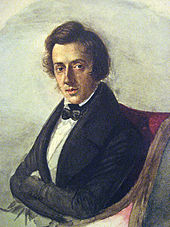 would disappear five years later, following Napoleon’s defeat at Waterloo, with that part of Poland reverting back to Russia). His father, Nicolas Chopin, was French, his mother, Tekla Justyna Krzyżanowska, – Polish. The first 20 years Frédéric lived in Poland, mostly in Warsaw, where his family moved when Nicolas received an appointment at the newly-established Warsaw Lyceum. Frédéric was a child prodigy (“Second Mozart,” the local press called him), both as a pianist and as a composer: a lithograph of a polonaise he wrote at the age of eight, survives to this day. He studied composition and the piano with the composer Józef Elsner, then entered the Warsaw Conservatory, where he also studied the organ. The organ played its role, even though Chopin never composed for this instrument: at the time, several attempts were made to combine the organ and the piano; one of these hybrids was called the “aeolopantaleon.” Young Chopin played this unusual instrument at a concert attended by Tsar Alexander I of Russia; the Tsar was very impressed and presented the 15-year-old Frédéric with a diamond ring. Even though the Chopins were well established, Frédéric felt stifled: compared to the European capitals or St.Petersburg, Warsaw was musically quite provincial. In November of 1830 he went on a European tour; the first stop was in Vienna. One week after his arrival he had learned of the Warsaw uprising against the Russians. Frédéric stayed in Vienna for half a year; in July of 1831 he left for Paris which would become his home for the rest of his life: he was never to see Poland again. By then, Chopin’s reputation as a brilliant pianist had been firmly established, but his creative genius was to flourish in France.
would disappear five years later, following Napoleon’s defeat at Waterloo, with that part of Poland reverting back to Russia). His father, Nicolas Chopin, was French, his mother, Tekla Justyna Krzyżanowska, – Polish. The first 20 years Frédéric lived in Poland, mostly in Warsaw, where his family moved when Nicolas received an appointment at the newly-established Warsaw Lyceum. Frédéric was a child prodigy (“Second Mozart,” the local press called him), both as a pianist and as a composer: a lithograph of a polonaise he wrote at the age of eight, survives to this day. He studied composition and the piano with the composer Józef Elsner, then entered the Warsaw Conservatory, where he also studied the organ. The organ played its role, even though Chopin never composed for this instrument: at the time, several attempts were made to combine the organ and the piano; one of these hybrids was called the “aeolopantaleon.” Young Chopin played this unusual instrument at a concert attended by Tsar Alexander I of Russia; the Tsar was very impressed and presented the 15-year-old Frédéric with a diamond ring. Even though the Chopins were well established, Frédéric felt stifled: compared to the European capitals or St.Petersburg, Warsaw was musically quite provincial. In November of 1830 he went on a European tour; the first stop was in Vienna. One week after his arrival he had learned of the Warsaw uprising against the Russians. Frédéric stayed in Vienna for half a year; in July of 1831 he left for Paris which would become his home for the rest of his life: he was never to see Poland again. By then, Chopin’s reputation as a brilliant pianist had been firmly established, but his creative genius was to flourish in France.
Two prominent 20th century pianists were born this week; both (obviously) played Chopin. Dame Myra Hess was born (likely) in London on this day in 1890. Already prominent as a keen interpreter of the music of Bach, Beethoven and Mozart, she became famous for establishing lunchtime concerts at the National Gallery during the War. Concerts took place Monday through Friday, no matter what. When London was being bombed by the Germans, the concerts were moved to a different, more secure, room. Almost 2000 concerts were presented, and Myra Hess played 150 of them. The Chicago-based free Dame Myra Hess concerts, which take place every Wednesday at 12:15 every week of the year, where established by the International Music Foundation in honor of that great British pianist. Here’s Myra Hess playing The Grande valse brillante in E-flat major, Op. 18.
Lazar Berman was born on February 26th of 1930 into a Jewish family in Leningrad. A child prodigy, he started playing piano at the age of two, and at four took part in a Leningrad “young talents” competition. Later, he studied with Alexander Goldenweiser at the Moscow Conservatory. In 1956 Berman won the Queen Elizabeth competition in Brussels and the Franz Liszt competition in Budapest. Berman was persecuted by the Soviet musical authorities more than almost any artist: from 1959 till 1971 he was prohibited from playing outside of the country because he married a French girl (the marriage was very brief), and then, in 1980, he was banned again, when a “wrong” book was found in his luggage. Berman was a phenomenal virtuoso (his Liszt recordings are stupendous), but partly for that reason the purely musical qualities of his playing were overlooked. Here is Chopin’s Etude in A minor, Op 25, No. 11 in a live recording made in 1950.Permalink
February 18, 2019. Handel. February 23rd is the birthday of George Frideric Handel, one of the greatest composers of the first half of the 18th century. A couple years ago we posted an entry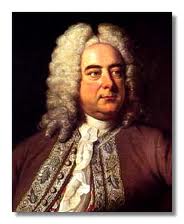 describing Handel’s move to London and his first years there, covering the period roughly between 1709 and 1719. In 1719 Handel was living in Cannons, a home of James Brydges, the Duke of Chandos, about 13 miles northwest of London’s center. The Duke, Handel’s patron, was a musician himself and maintained an orchestra of 24 players. Handel’s stay at Cannons was comfortable and productive: he composed, among other things, Chandos Anthems (eleven in total), and the first English oratorio, Esther. (Here is Chandos Anthem no. 11, "Let God Arise." It’s performed by The Sixteen, directed by Harry Christophers). In 1719 an opera company, called “Royal Academy of Music” was organized. The Academy was set up as a joint stock company; the original issue was oversubscribed, so many people wanted to get involved. The funding partners were members of the nobility, well-traveled and familiar with opera, often amateur musicians themselves. Their goal was to create a permanent home for Italian opera in London. Handel was tasked with finding the singers, for which he traveled to Germany rather than Italy, but the singers he engaged for the Academy were all Italians, the famous castrato Senesino among them. Upon returning to London Handel was appointed “Master of the Orchester with a Sallary.” The first opera season was short, though Handel produced a new opera, Radamisto; it premiered in April of 1720, the performance attended by King George I and the Prince of Wales, the future George II. Originally the role of Radamisto was sung by a soprano, but during the next season, in a revised version, it was Senestino in his first year in London. That season saw the premier of Handel’s Floridante, very successful and revived in the following seasons. Again, Senesino sung the title role. It’s interesting that the singers were considered much more important than composers and commanded much higher salaries (Senesino’s salary the first year at the Academy was above £2000, an enormous sum). Handel was known to quarrel with the singers often, even with his favorite Senesino: eventually they broke up and Senesino joined the rival Opera of the Nobility. The first couple of seasons Handel’s standing was not as secure as it would seem, considering his position of music director: Giovanni Bononcini, an Italian composer, was a rival, maybe even more famous these first years. The following years saw the ascendancy of Handel at Bononcini’s expense. For the fourth season Handel wrote Ottone, which again featured Senesino in the title role, and also the famous Italian soprano Francesca Cuzzoni as Teofane, Ottone’s future wife. She would sing at the Academy for five more seasons, creating, among others, the role of Cleopatra in Giulio Cesare. (Here’s the aria Vieni, o figlio from Ottone, sung by Lorraine Hunt. Philharmonia Baroque Orchestra is conducted by Nicholas McGegan). The Royal Academy of Music lasted for nine years, through the 1728-29 season, collapsing under the weight of huge salaries paid to the lead singers. It reconstituted itself as New Academy a year later. During those years Handel created 13 operas; Giulio Cesare, being the most famous, but also such masterpieces as Rodelinda and Tamerlano. He also wrote several anthems for the coronation of George II (George I died unexpectedly on June 22nd of 1727), one of which, Zadok the Priest, has been sung at every coronation ceremony since that time. Handel became a British citizen in February of 1727; even before that he was made Composer of Music for His Majesty’s Chapel Royal and taught music to royal princesses. Even though the Academy was no more, things were looking good. Handel was famous, well to do, and only 44.Permalink
describing Handel’s move to London and his first years there, covering the period roughly between 1709 and 1719. In 1719 Handel was living in Cannons, a home of James Brydges, the Duke of Chandos, about 13 miles northwest of London’s center. The Duke, Handel’s patron, was a musician himself and maintained an orchestra of 24 players. Handel’s stay at Cannons was comfortable and productive: he composed, among other things, Chandos Anthems (eleven in total), and the first English oratorio, Esther. (Here is Chandos Anthem no. 11, "Let God Arise." It’s performed by The Sixteen, directed by Harry Christophers). In 1719 an opera company, called “Royal Academy of Music” was organized. The Academy was set up as a joint stock company; the original issue was oversubscribed, so many people wanted to get involved. The funding partners were members of the nobility, well-traveled and familiar with opera, often amateur musicians themselves. Their goal was to create a permanent home for Italian opera in London. Handel was tasked with finding the singers, for which he traveled to Germany rather than Italy, but the singers he engaged for the Academy were all Italians, the famous castrato Senesino among them. Upon returning to London Handel was appointed “Master of the Orchester with a Sallary.” The first opera season was short, though Handel produced a new opera, Radamisto; it premiered in April of 1720, the performance attended by King George I and the Prince of Wales, the future George II. Originally the role of Radamisto was sung by a soprano, but during the next season, in a revised version, it was Senestino in his first year in London. That season saw the premier of Handel’s Floridante, very successful and revived in the following seasons. Again, Senesino sung the title role. It’s interesting that the singers were considered much more important than composers and commanded much higher salaries (Senesino’s salary the first year at the Academy was above £2000, an enormous sum). Handel was known to quarrel with the singers often, even with his favorite Senesino: eventually they broke up and Senesino joined the rival Opera of the Nobility. The first couple of seasons Handel’s standing was not as secure as it would seem, considering his position of music director: Giovanni Bononcini, an Italian composer, was a rival, maybe even more famous these first years. The following years saw the ascendancy of Handel at Bononcini’s expense. For the fourth season Handel wrote Ottone, which again featured Senesino in the title role, and also the famous Italian soprano Francesca Cuzzoni as Teofane, Ottone’s future wife. She would sing at the Academy for five more seasons, creating, among others, the role of Cleopatra in Giulio Cesare. (Here’s the aria Vieni, o figlio from Ottone, sung by Lorraine Hunt. Philharmonia Baroque Orchestra is conducted by Nicholas McGegan). The Royal Academy of Music lasted for nine years, through the 1728-29 season, collapsing under the weight of huge salaries paid to the lead singers. It reconstituted itself as New Academy a year later. During those years Handel created 13 operas; Giulio Cesare, being the most famous, but also such masterpieces as Rodelinda and Tamerlano. He also wrote several anthems for the coronation of George II (George I died unexpectedly on June 22nd of 1727), one of which, Zadok the Priest, has been sung at every coronation ceremony since that time. Handel became a British citizen in February of 1727; even before that he was made Composer of Music for His Majesty’s Chapel Royal and taught music to royal princesses. Even though the Academy was no more, things were looking good. Handel was famous, well to do, and only 44.Permalink
February 11, 2019. Praetorius and Cavalli. A prolific and talented German composer of the late Renaissance, Michael Praetorius was born on February 15th of 1571. We dedicated an entry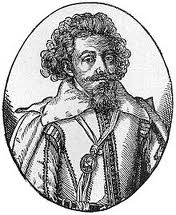 to him quite recently, so this time we’ll just play one of his pieces. Praetorius wrote more than 1000 sacred compositions and only one secular collection of French dances, which he called Terpsichore. Here’s one of them, La Bourrée. The unusual and very refreshingly sounding wind instrument you hear in this piece is called Rackett. Racketts come in four sizes, from soprano to great bass. Praetorius, who was not only a composer but also a musicologist, wrote about racketts in his book Syntagma Musicum: “In resonance racketts are quite soft, almost as if one were blowing through a comb. They have no particular grace when a whole consort of them is used together; but when viols da gamba are used with them, or when a single rackett is used together with other wind or stringed instruments and a harpsichord or the like, and is played by a good musician, it is indeed a lovely instrument. It is particularly pleasing and fine to hear in bass parts.”
to him quite recently, so this time we’ll just play one of his pieces. Praetorius wrote more than 1000 sacred compositions and only one secular collection of French dances, which he called Terpsichore. Here’s one of them, La Bourrée. The unusual and very refreshingly sounding wind instrument you hear in this piece is called Rackett. Racketts come in four sizes, from soprano to great bass. Praetorius, who was not only a composer but also a musicologist, wrote about racketts in his book Syntagma Musicum: “In resonance racketts are quite soft, almost as if one were blowing through a comb. They have no particular grace when a whole consort of them is used together; but when viols da gamba are used with them, or when a single rackett is used together with other wind or stringed instruments and a harpsichord or the like, and is played by a good musician, it is indeed a lovely instrument. It is particularly pleasing and fine to hear in bass parts.” .jpg) Hard to disagree, it is a lovely instrument indeed.
Hard to disagree, it is a lovely instrument indeed.
Francesco Cavalli was born Francesco Caletti on February 14th of 1602 in Crema, Lombardy. His first patron, the Venetian Governor’s name was Federico Cavalli. Cavalli heard Francesco sing in the local cathedral and convinced the boy’s family to let him take Francesco to Venice. Some years later, already a well-known composer, Francesco assumed the name of his first patron. In 1639 Cavalli won a competition to become the second organist at St. Mark’s; that same year he composed his first opera, Le nozze di Teti e di Peleo. Even though at the time operas had been played in private houses for about 40 years, it had just been two years since this art form became available to a broad paying public. Le nozze was staged at Teatro San Cassiano, Venice’s first public opera house, opened in 1637. During the following 10 years Cavalli wrote eight more operas, Giasone becoming one of the most popular in all of Italy. In the following years, Cavalli, together with his favorite librettist, Giovanni Faustini, worked in the newly established Sant' Apollinare theater, famous for its advanced stage machinery. Faustini died in 1661, and Cavalli moved to the Teatro Santi Giovanni e Paolo, which was managed by Marco Faustini, Giovanni’s brother. Santi Giovanni e Paolo was considered the most comfortable of all opera theaters in the city (by the end of the 17th century Venice had 10 of them). These years saw the creation of Egisto, Xerse and Erismena, which, together with Giasone, became the staples of the opera repertoire and were performed all over Italy, in cities large and small. In 1660 Cardinal Mazarin, the French Prime Minister (he was an Italian born Giulio Raimondo Mazzarino) invited Cavalli to Paris to compose an opera for the planned marriage of Louis XIV to Maria Theresa, daughter of the King of Spain. The visit, which lasted almost two years (the new Tuileries theater, where the opera was supposed to be staged, had not been completed, as promised) was not a happy affair. Jean-Baptiste Lully schemed against his rival, and with the death of Mazarin in March of 1661 the influence of all things Italian had waned. Cavalli composed the opera Ercole amante (it was successfully staged in Chicago a couple years ago) but the temporary theater in which it was premiered had terrible acoustics. Plus, Lully came up with additional ballet numbers, making the performance way too long, but the dances was the only thing that got the King interested. Cavalli left France in May of 1662. Back in Venice, he was made the maestro di cappella of St. Mark’s in 1668 but continued composing operas: altogether, he wrote more than 40. Cavalli died in Venice on January 14th of 1676. Here’s the aria Delizie, contenti from his opera Giasone. The counter-tenor Christophe Dumaux is Giasone, Federico Maria Sardelli conducts the Symphony orchestra of Flemish opera Antwerp/Ghent.Permalink
February 4, 2019. Berg, Leinsdorf, Björling. We have three anniversaries this week, that of a composer, a conductor, and of a tenor. The composer is Alban Berg, born on February 9th of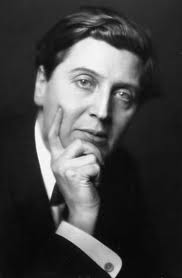 1885 in Vienna. One of the greatest modernists of the 20th century, he is mostly known for two groundbreaking operas: Wozzeck, the first atonal opera of the 20th century, which Berg completed in 1922, and Lulu, which he started in 1929 and worked on for the next seven years till his death in 1935, still leaving it incomplete. The libretto for Wozzeck Berg wrote himself, following Georg Büchner’s play Woyzeck; Berg also wrote the libretto for Lulu, this time based on the play, Erdgeist, by another famous German playwright, Frank Wedekind. By the time of Berg’s death, anti-Semitism was rampant not just in Nazi Germany but in Austria as well. Berg’s “problem” was that he was a student of Arnold Schoenberg, a Jew. Wozzeck stopped being performed in 1932, and all of Berg’s music was prohibited in Germany in 1935 as “degenerate music.” Wozzeck, as complex as it was, proved that an atonal work could bring enough auditory, rhythmical and emotional dynamics to keep listeners rapt for 100 minutes. Lulu was even more difficult and, at approximately three hours, much longer. It was premiered, in its incomplete form, in 1949: Berg’s widow, Helen, wanted Schoenberg to complete the score but the master declined; Helen wouldn’t let anybody else touch it. Following Helen Berg’s death in 1976, Austrian composer Friedrich Cerha completed the orchestration of the 3rd act. The first performance of the complete opera took place in Paris’s Palais Garnier in 1979 with Pierre Boulez on the podium. This became the standard version, performed in major opera houses. Here are five minutes from Act III ("Wer ist das?" – “Who is this?”). Teresa Stratas (she was one of the best Lulus on the opera scene) sings the role of the protagonist; Franz Mazura is Jack. Pierre Boulez conducts Orchestre de l'Opéra de Paris.
1885 in Vienna. One of the greatest modernists of the 20th century, he is mostly known for two groundbreaking operas: Wozzeck, the first atonal opera of the 20th century, which Berg completed in 1922, and Lulu, which he started in 1929 and worked on for the next seven years till his death in 1935, still leaving it incomplete. The libretto for Wozzeck Berg wrote himself, following Georg Büchner’s play Woyzeck; Berg also wrote the libretto for Lulu, this time based on the play, Erdgeist, by another famous German playwright, Frank Wedekind. By the time of Berg’s death, anti-Semitism was rampant not just in Nazi Germany but in Austria as well. Berg’s “problem” was that he was a student of Arnold Schoenberg, a Jew. Wozzeck stopped being performed in 1932, and all of Berg’s music was prohibited in Germany in 1935 as “degenerate music.” Wozzeck, as complex as it was, proved that an atonal work could bring enough auditory, rhythmical and emotional dynamics to keep listeners rapt for 100 minutes. Lulu was even more difficult and, at approximately three hours, much longer. It was premiered, in its incomplete form, in 1949: Berg’s widow, Helen, wanted Schoenberg to complete the score but the master declined; Helen wouldn’t let anybody else touch it. Following Helen Berg’s death in 1976, Austrian composer Friedrich Cerha completed the orchestration of the 3rd act. The first performance of the complete opera took place in Paris’s Palais Garnier in 1979 with Pierre Boulez on the podium. This became the standard version, performed in major opera houses. Here are five minutes from Act III ("Wer ist das?" – “Who is this?”). Teresa Stratas (she was one of the best Lulus on the opera scene) sings the role of the protagonist; Franz Mazura is Jack. Pierre Boulez conducts Orchestre de l'Opéra de Paris.
Erich Leinsdorf was also born in Vienna, on February 4th of 1912. As a young conductor, he assisted Bruno Walter and Arturo Toscanini at the Salzburg Festival for three years, from 1934 to 1937. In November of 1937, Leinsdorf, who was Jewish, traveled to the United States. Four months later, Nazi Germany took over Austria in the infamous Anschluss; Leinsdorf stayed in the US and became a citizen in 1942. Leinsdorf had led several major American orchestras, from the Cleveland to the Boston, he also had a long association with the Metropolitan opera. Here is Overture and Venusberg Music from Wagner’s Tannhäuser. Erich Leinsdorf leads the Boston Symphony Orchestra in the 1964 recording.
Jussi Björling was one of the supreme tenors of the 20th century. He was probably the only non-Italian who was an equal to the greatest Italian tenors in the Verdi repertoire. Björling was born in the town of Borlänge in central Sweden on February 5th of 1911. He made his professional debut at the Royal Swedish Opera in 1930. Recognition came to him early: in 1936 he debuted at the Vienna Opera, and one year later he sung in Chicago. He first performed at the Met was in 1938 and at the Covent Garden – in 1939. Björling had an exceptionally beautiful voice which had an amazing consistency from the top to bottom of his register. Björling’s life was tragically short: he died at the age of 49 after suffering a heart attack during a performance of La Boheme at Covent Garden six months earlier (he completed the performance). Here’s Jussi Björling in the aria Una furtiva lagrima" from Act II of L'elisir d'amore by Gaetano Donizetti. This recording was made in December of 1947.Permalink
January 28, 2019. Old and new; composers and performers. This week has so many anniversaries that they turn our post into a list, but we’d rather that than omit anybody. Five composers were born this week; they span two and a half centuries, from the Baroque to today. The oldest is Alessandro Marcello, born on February 1st of 1673. His younger brother, Benedetto Marcello, is better remembered these days, but Alessandro’s Oboe Concerto (here) was good enough for Bach to transcribe it for the keyboard solo; we now know it as Bach’s Concerto BWV 974.
Franz Schubert was born on January 31st of 1797 in Himmelpfortgrund, now part of Vienna’s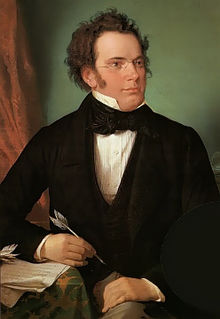 9th district. Undoubtedly one of the greatest composers in the history of European music, he wrote, during his short thirty-one-year life, an astounding number of masterpieces. In their profundity, his late piano sonatas could be compared only to those of the late Beethoven. His symphonies are among the best in the 19th century literature, his sacred works are very interesting, but it’s the Lieder, the art songs, that truly set him apart. His song cycles, Die schöne Müllerin, Winterreise, Schwanengesang, are works of pure genius. And so are some individual songs. Here, for example, is An Sylvia. It’s sung by a young American mezzo, Clara Osowski. Mark Bilyeu is on the piano.
9th district. Undoubtedly one of the greatest composers in the history of European music, he wrote, during his short thirty-one-year life, an astounding number of masterpieces. In their profundity, his late piano sonatas could be compared only to those of the late Beethoven. His symphonies are among the best in the 19th century literature, his sacred works are very interesting, but it’s the Lieder, the art songs, that truly set him apart. His song cycles, Die schöne Müllerin, Winterreise, Schwanengesang, are works of pure genius. And so are some individual songs. Here, for example, is An Sylvia. It’s sung by a young American mezzo, Clara Osowski. Mark Bilyeu is on the piano.
Felix Mendelssohn was also born this week, on February 3rd of 1809. We just talked about Schubert; Mendelssohn was one of the key people who promoted Schubert’s music which – inexplicably – faded from people’s memory soon after Schubert’s death. He, for example, premiered Schubert’s Symphony no. 9 in 1839 (the manuscript was discovered by Robert Schumann). You can read about Mendelssohn here and here. We understand that Mendelssohn, one of the greatest composers of the 19th century, deserves much more, and we’ll try another time. For now, here’s Mendelssohn’s String Quartet No. 6 in F minor, Op. 80. It’s his last large-scale work and was completed in September of 1847, as a “Requiem” for his beloved sister Fanny, who died in May of that year. Felix would be dead two months later, on November 4th of 1847. The performers are the Artemis Quartet.
Two very different modern composers were also born this week: John Tavener and Luigi Nono, Tavener on January 28th of 1944, Nono – on January 29th of 1924. Their art is a testimony to the tremendous depth and diversity of modern music. Tavener, a deeply devout man (he converted from the Presbyterian to the Orthodox church) wrote mostly religious music. In its stillness, the music of Tavener reminds us that of Arvo Pärt. Here’s his The Last Sleep of the Virgin for a String quartet and handbells. It’s performed by the Chilingirian Quartet and Iain Simcock, a composer and organist, playing the bells. Luigi Nono was a very different kind of composer: a dedicated avant-gardist, he was close to his Darmstadt fellows such as Karlheinz Stockhausen and Pierre Boulez. Here’s an example of his work, a suite from Prometeo, a theatrical work, which could be called opera or a set of oratorios, though Nono disliked typecasting his compositions. Claudio Abbado leads the Lucerne Festival Orchestra and soloists.Four great performers were also born this week. None of them need an introduction: Arthur Rubinstein, on January 28th of 1887, Fritz Kreisler – on February 2nd of 1875, Jascha Heifetz – on the same day but in 1901, and Renata Tebaldi, the great soprano and Maria Callas’s rival – on February 1st of 1922.Permalink
January 21, 2019. Mozart and more.Wolfgang Amadeus Mozart was born this week, on January 27th of 1756. We write about him regularly – it couldn’t be otherwise as Mozart is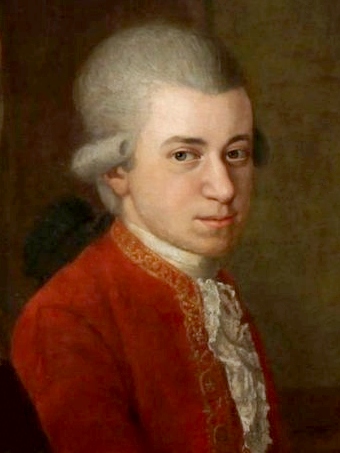 the seminal figure in the history of Western music. So this time, to celebrate Mozart we’ll play a celebratory music composed by Mozart himself. The story of this piece starts with the Haffners, a prominent Salzburg family whom Mozart knew well. Sigmund Haffner the Elder was the mayor of Salzburg; Sigmund Haffner the Younger was Mozart’s friend. In 1776 Haffner Jr. commissioned Mozart to write music for the wedding of his sister, Marie Elisabeth. Mozart came up with a Serenade in D Major (K. 250), which we know as Haffner Serenade. Six years later the occasion was the ennoblement of Sigmund Haffner himself. Again, Mozart was asked for a musical accompaniment, and even though Mozart was very busy at the time, he composed yet another serenade, except that he didn’t stop there but developed the serenade into a symphony, which we know as Symphony No. 35 in D major, K. 385, Haffner. Here it is, performed by the Academy of St. Martin in the Fields under the direction of Iona Brown.
the seminal figure in the history of Western music. So this time, to celebrate Mozart we’ll play a celebratory music composed by Mozart himself. The story of this piece starts with the Haffners, a prominent Salzburg family whom Mozart knew well. Sigmund Haffner the Elder was the mayor of Salzburg; Sigmund Haffner the Younger was Mozart’s friend. In 1776 Haffner Jr. commissioned Mozart to write music for the wedding of his sister, Marie Elisabeth. Mozart came up with a Serenade in D Major (K. 250), which we know as Haffner Serenade. Six years later the occasion was the ennoblement of Sigmund Haffner himself. Again, Mozart was asked for a musical accompaniment, and even though Mozart was very busy at the time, he composed yet another serenade, except that he didn’t stop there but developed the serenade into a symphony, which we know as Symphony No. 35 in D major, K. 385, Haffner. Here it is, performed by the Academy of St. Martin in the Fields under the direction of Iona Brown.
Several talented musicians were also born this week. Wilhelm Furtwängler, one of the most important conductors of the 20th century, was born on January 25th of 1886 in Schöneberg, a district of Berlin. Furtwängler is such an immense and complicated figure that we would need more than one entry to even begin to describe him. So for now, here’s a brief sketch of the first half of his life. Even though he was born in Berlin, Furtwängler spent his childhood in Munich, were his father, a prominent archeologist, received a professorship. When it became obvious that Wilhelm is an extremely gifted child, his parents took him out of public school and hired tutors to educate him privately. He learned to play the piano at an early age; he started composing at the age of seven. (Most of his life he thought of himself as a composer first and conductor second – he started conducting in order to perform his own works. The public and the critics disagreed). From the beginning of his conducting career it was Beethoven who interested him the most. Starting at 1905, he guest-conducted in Breslau, Zurich, the Munich Hofoper and the Strasbourg Opera. In 1911, at the age of just 25, he was appointed the director of the Lübeck Opera, where he worked for four years. Then, from 1915 to 1920, he directed the Mannheim Opera. In 1920, Furtwängler succeeded Richard Strauss as the director of the Berlin Staatskapelle, the orchestra of the Berlin State Opera. He also conducted the Frankfurt Museum concerts following the departure of Willem Mengelberg. When Arthur Nikisch died in 1922, it was only natural that Furtwängler succeed him at the Leipzig Gewandhaus Orchestra and the Belin Philharmonic. These were some of the most coveted conducting positions in the world, but the most creative (and controversial) phase of his career was only beginning. Here’s a recording of The Siegfried Idyll, music that Wagner wrote as a birthday present for his wife Cosima in 1869 and later incorporated into his opera Siegfried. Furtwängler leads RAI National Symphony Orchestra (Italians playing Wagner!), the recording quality is not terribly good even though it was made in 1952, but the performance is alive, it breathes, moves forward, despite (or is it because of?) Wagner’s endless repeats.
Also, two great British performers, whose careers were tragically short, were born this week. Jacqueline du Pré whose recording of Elgar’s concerto is a classic, was born on January 26th of 1945. She stopped playing in 1971, at the age of26, and was diagnosed with multiple sclerosis two years later. She died on October 19th of 1987. John Ogden, a pianist, was born on January 27th of 1937. Ogden shared the First prize with Vladimir Ashkenazi at the 1962 Tchaikovsky competition. He had a mental breakdown in 1973, spent the following 10 years in a hospital and after that performed only sporadically. Ogden died on August 1st of 1989.Permalink